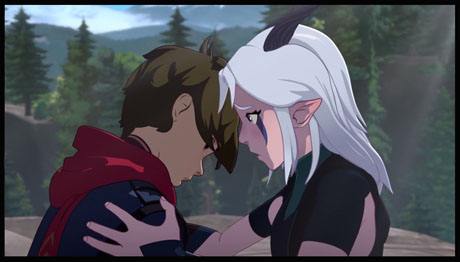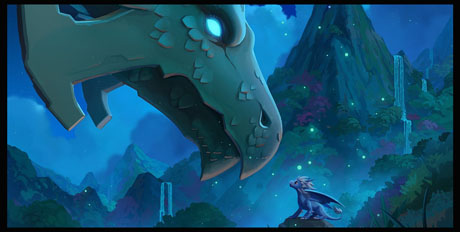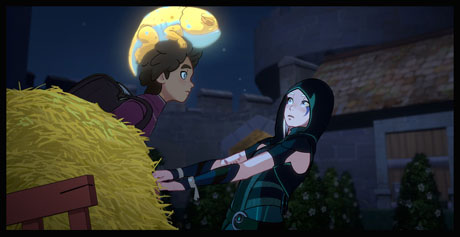
In the world of The Dragon Prince, the fate of mankind—and the magical beings of Xadia—rests upon two unlikely allies: Rayla, a Moonshadow Elf trained to kill, and Prince Callum, a young Human struggling to learn primal magic. Their mission: to travel to a faraway land and safely return the newly-hatched Dragon Prince back to his mother. If they fail, a war could obliterate all life on their island continent.
In reality, the actors playing these roles are key to the success of Wonderstorm’s Dragon Prince franchise. Combined with the writing and animation, their performances must be convincing enough, and appealing enough, for the viewers to root for. Otherwise, they’ll switch to another show. Or decide not buy the books, games, and action figures.

Rayla’s voice comes from Paula Burrows, primarily a live-action actor, with credits in Supernatural, The Dangers of Online Dating, Freaky Friday (2018) and Unspeakable. For her, doing voiceovers for animation is a new experience.
“It’s been amazing,” she says. “I’m so fortunate that this was my introduction to the world of animation, because the team is so nurturing and creative, and they’ve really shown me the ropes and taken care of me.
“Just like anything I audition for with voice, it always comes through as an email. I had just started auditioning for voice, I think, a couple weeks before. So I wasn’t invited into any room. I sent in an mp3. I didn’t hear anything for a few weeks, and then I got called into the room, and I did an in-person audition. A month after that I got booked.”
Prince Callum’s voice belongs to Jack De Sena, a writer/actor prolific in both live-action and animation. His on-camera credits include All That, Dorm Life, Battleground and 100 Things to Do Before High School. In animation, he voiced Sokka in Avatar: The Last Airbender, Kevin in King of the Hill, Jimmy Olsen in The Batman, Rand/Lance in Generator Rex, and Robin the Boy Wonder in JLA Adventures: Trapped in Time.
“I had worked with Aaron Ehasz and Giancarlo Volpe on Avatar: The Last Airbender,” De Sena recalls. “Maybe four years ago, we were at San Diego Comic-Con for an Avatar panel, and they, afterwards, were like, ‘Hey, hey, hey, come here, let’s find some time soon for you to come by our offices in L.A. We want to show you a thing we’re working on.’ I went to that having really very little context, no idea what it was, thinking if there was a show, maybe I’d get a chance to audition for it. But they brought me in, sat me down, gave me the full pitch: ‘Here’s what Dragon Prince is; here’s the world; here’s this character Callum.’

Paula Burrows and Jack De Sena
“I got to really see their full vision for it, and in that conversation, it felt like a very natural fit. They had had me in mind for this role after working with me on Avatar, so yes, this was a very unusual process for me, where it wasn’t just a normal audition thing. This was getting the opportunity to work with people who I’ve worked with before and explore this new world with them.”
Because De Sena lives in California, he’s flown to Vancouver, B.C. for the recording sessions, where he performs alongside Paula Burrows and the rest of the cast.
“Occasionally people would have to remote in, but for pretty much everything we were all in the same room and were able to do it in script order and play out scenes in full,” he says. “It was mainly just running the scenes together a lot, which is great. It gives a real natural, playful energy.”
“For me, definitely, I have done recording by myself, not for animation but for commercial,” Burrows says. “I don’t have voice acting training; I have acting training. So that’s what I’m relying on to guide me. So to not have another actor, for me, would feel like a loss. You would have to be creating a lot outside of yourself to connect in the same way.”
Burrows found herself cast in recurring roles, like Opeli, High Councillor of Katolis, and Berto the chatty parrot—without auditioning.
“I just got an email the night before saying, ‘Paula will be playing Berto’,” she says with a chuckle. “I went in the next morning and gave it a try. I also play Opeli, but originally I think I was just temping her.”
“Yeah, and they kept it,” De Sena says.
“She just kept appearing, so then I was there all the time. I think it was just easier to have me continue,” Burrows says.
It turns out that De Sena did vocalizations for Bait, the glow toad, and for baby Azymondias (“Zym”).
“I don’t know in the final edit how much of it is actually any human voice, but I temp it,” De Sena says. “When we were in the studio, I was the one who would read as Bait for those moments. I did a day of Bait and I also did Zym. I temped Zym as well. But I don’t know honestly, in the end, how much of that is in there or not.”
“He’s so good at tiny creatures,” Burrows points out.

Voice direction came from several people: creators/producers Aaron Ehasz, Justin Richmond and Bardel directors Giancarlo Volpe, Villads Spangsbert and Meruan Salim — though not all at once.
“They rarely came all together, and they also discuss between themselves before they let us here,” Burrows says.
Coming from the live-action arena, how do the actors perform by using their voice alone?
Says De Sena, “There’s definitely tools that aren’t at your disposal, so you have to turn up the volume on some of the other elements and focus on them. But I would say the core of it is quite similar. The biggest part is just acting things well and with intention. I have to trust that when it’s animated, there will be a nice beat here and a dry look and whatever.”
“It is nice to get to play more in the world of theatricality than on film can be,” Burrows says. “You can go a little bigger with animation, which is more, I think, reminiscent of being on stage than being in front of a camera. So I think there’s a lot of fun in that bigness. But no, I think for me it’s very similar how I prepare.”
De Sena concurs. “Right, the preparation is very similar, especially once you have the character established. Thinking about developing a character for animation, I just focus more on vocal textures and what stuff I can add or take away from my own voice.”
When an actor learns whether his character matures in the unfolding story, they can adjust their performance accordingly—as Jack De Sena did, and does, with Callum.
“In Season Two, when [Callum is] in that post-dark magic dreamscape and is discovering the arcanum within himself and interacts with a distorted but a fully-realized powerful version of himself– Dark Magic Callum. I imagined it as himself older, after having followed this path of dark magic. I definitely settled my voice and dropped down a little, matured it a little, and tried to play with that throughout the course of Season One and Season Two, knowing that that’s where this is going. I started the character younger-feeling and specifically played a lot with poor breath control.

“Since it’s a character who is maturing in his ability to channel his breath, control his breath to perform magic, I specifically kept in a lot of choppy, anxious, short constructions of sentences and stuff where he’s just sort of stuttering and isn’t fully in control of his voice, of his breath, and throughout.”
Burrows asks, “How much did you know before we started?”
“I definitely knew from Aaron’s writing in Avatar, this isn’t going to be a short, procedural thing; this is going to be a long, serialized arc,” De Sena says. “I knew there was going to be a coming-of-age story, there was going to a maturation process. And the character at the beginning starts really anxious. All the interactions with Claudia were so fumbly, that I knew like, “Oh, we can get really fumbly and then find these other places later of confidence and more control and more settled.”
“But no, I don’t want to act like I knew from the beginning that I was doing this breath thing; that was more stuff that I was discovering in Season Two when reading, like, ‘Okay, this is what he’s working on. He’s working on channeling his breath and being connected to the sky.’ So that meditative stuff in Season Two helped me find some more contrast in my voice, give it a place to go.
“I definitely figured, start him younger, start him more anxious. Also the character’s [age is] 14 at the beginning, and I knew like, ‘Hey, we got time, we’ll explore this; the voice can shift; there can be a natural aging.’—which is still happening.”
One of the show’s hallmarks is the nuances of the characters emoting, gesturing, or fighting in exquisitely-choreographed combat. Are the voice actors filmed for reference?
“We’re not at all, that’s just fantastic animating,” De Sena says.
“We’re not, but I do know that the creators have filmed things in the past,” Burrows says.
“As animation reference, filming themselves,” De Sena adds.
“Not us, but if there’s something specific that they wanted. But the animators are so good, oh, gosh. But yeah,” Burrows says.
“The team at Bardel, the animation house, their board artists and animators all the way through, are just so talented,” De Sena enthuses. “There were so many of those sequences—like Viren with the mirror: three, four lines of stage direction in a script full of dialogue, and reading that very quickly and seeing what that becomes in the finished product is just mind-blowing.”
During the show, when the magic-spinners cast their spells, it sounds like they’re speaking backwards. How does one speak backwards?
“They’ve scripted lines of spell that are then played backwards with some effects on them,” De Sena reveals. “There was an attempt to see how it would work. It was Jason [Simpson], for Viren. He would record real words, they’d play it backwards, and then he would listen to the backwards words and try to say those sounds forward. But I think what they landed on is mostly it’s played backwards. I had some of that in Season Two; I do a little bit of dark magic. But mostly it was Jason and Racquel [Belmonte], who plays Claudia.”
When Callum uses dark magic, he plunges into a catatonic state, from which it takes awhile to recover. After that experience, would he tap into the dark side again?
De Sena acknowledges, “There is a part of him that wants this [power] so badly. Desperation that could push him in that direction, but my personal hope is that he’s continuing in a positive relationship, having now found it within himself. But yeah, it can go too far. We’ll see.”
“One of the most interesting things about this world is the characters aren’t black and white. They do live in some gray area, so it will be interesting to see what happens with Callum and the dark magic,” Burrows says.
“The fan support to this point has been so incredibly awesome,” Jack De Sena says. “That’s going to allow more of this to get made. We have a ton more stories to tell.”
Paula Burrows adds, “I hope that those people that love our show know how much we love it, too, and want to keep giving to it. We will as much as we can.”
Interviewed at Comic-Con International: San Diego, Hilton Bayfront Hotel, 1 Park Blvd., San Diego, CA 92101, July 20, 2019. Special thanks to Justin Santistevan, Co-Founder and President of Wonderstorm and Jennifer Greene of Illuminate-Communications.
BELOW: “Written in the Stars”, a skit performed by Paula Burrows and Jack De Sena at Comic-Con International: San Diego 2019, July 20, 2019.
- INTERVIEW: Aaron Ehasz, Justin Richmond on “The Dragon Prince: Mystery of Aaravos”: The Right Choice for the Voice - March 20, 2024
- INTERVIEW: “The Dragon Prince” Influences, Inspirations, and the Mystery of Simpson - March 11, 2024
- INTERVIEW: The Magic of Her Voice: Paula Burrows of “The Dragon Prince” - October 4, 2023


 August 5th, 2019
August 5th, 2019  W.R. Miller
W.R. Miller  Posted in
Posted in  Tags:
Tags: 






